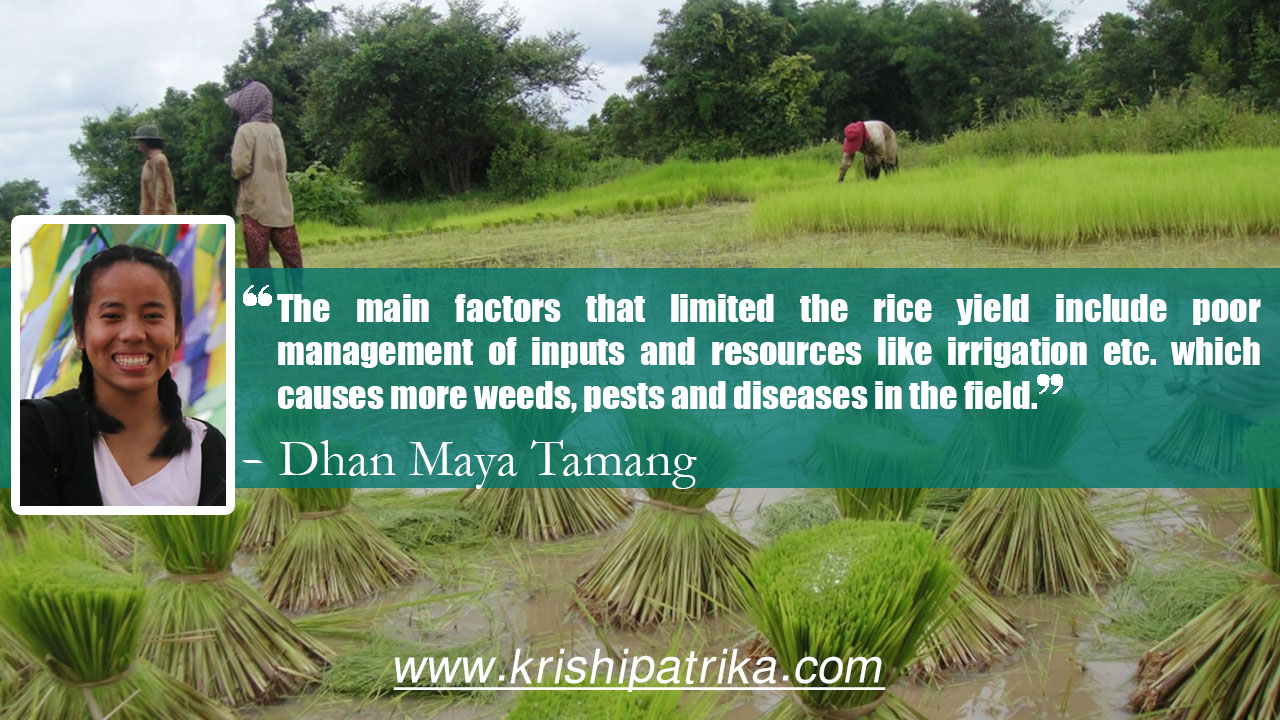
Rice is the major staple food crop of our country, Nepal which provides more than 50% of the calorie requirement of the Nepalese people followed by wheat and maize (Pokhrel, n.d.), where about 46% of the total cultivated land is covered by rice. Not only for Nepal, but also for whole Asian countries it is considered as a staple food. Rice is the number one crop in terms of production, consumption and cultivated area. Economic growth of our country is directly affected by cereal crop (especially rice) which contributes one-fourth Gross Domestic Product (GDP) and more than two-thirds of farm household income is generated from rice production.
POPULAR RICE VARITIES
The popular rice varieties grown in the three agro-ecological zones of our country, Nepal are listed below:
IN TERAI
Chaite 4 (in spring) (feb/march-june/july), Chaite 2, Bindeshwari, Ch-45, Mahsuri also called (Masuli in Nepal), Janaki.
Upland Rice (Ghaiya)
IN HILLS
Khumal4, Taichung 176, Radha 4 etc.
Ch 45, the spring variety is the most popular rice in Terai Region. It is cultivated up to an altitude of 900m. Nowadays Ch4 and Ch2 are replacing Ch45. Bindeshwari is that variety of rice which is grown largely when the rainfall is high i.e. it is a rain-fed variety which is grown in lowland during main season. At first Masuli was released in 1973 and is still popular among the people while it is being replaced by Savitri in the western and central Terai region. An upland variety Ghaiya-2 is grown under irrigated condition in spring season which yield is extremely high i.e. more than 5 tonnes/hectare. Meanwhile in the mid hill region, Taichung176 and Khumal4 variety are popular in Kathmandu valley. Also many local varieties are grown in different remote areas of hill.
Similarly, multi-cropping pattern is used in Nepal where two cereal crops are cultivated in the same field like rice-wheat, rice-maize and rice-mustard.
SCOPE OF RICE CULTIVATION
Rice is one of the major important food grains which is considered as life for more than 50% population all around the world. The product released from rice are very useful in daily life like straw which is used as cattle feed, roof thatching, for making mats and other little materials like hat etc. Rice bran is also used in oil extraction which is highly consumed by human beings and also it is used in making soaps etc. Due to the growing population, the demand of rice is increasing day by day which means farmer can grow more rice by producing high yielding varieties and utilizing the bare land by managing it properly which means utilization of land in proper manner. It provides income opportunity to the farmer and also it plays as an educational tool among the farmers. and there is scope for increasing Basmati rice production in Nepal with new high yielding varieties according to the farmer from rural area due to high demand in market in present days.
CHALLENGES OF RICE CULTIVATION
There are many challenges with the rice production systems. The main factors that limited the rice yield include poor management of inputs and resources like irrigation etc. which causes more weeds, pests and diseases in the field. In rain-fed lowland the challenges include adverse climate, drought, pests, weeds, poor soil, water, crop management technologies which directly affect the rice production. In upland dry-DSR environment, the main problem are biological constraints such as weeds, nematodes, poor soil fertility and lack of productive varieties to the climatic conditions of upland and in drought conditions. And the main challenge of rice cultivation of Nepalese farmer is that they don’t get a variety of seed in market in appropriate time so they had to leave their land bare. also farmers are using higher dose of fertilizer compared to the standard recommended dose due to lack of knowledge especially in rural areas which causes the less productivity of rice. And due the lack of required technologies in field, the productivity of rice is decreasing.
In order to improve the productivity of rice, effective strategies production system should be applied and the high yielding varieties of seeds should be provided to the farmer. Appropriate training and education should be provided to the farmers about the cultivation of different cereal crops.









